Abstract
Well leakage is a recurring hazard in drilling operations that can lead to significant loss of drilling fluids and serious consequences when drilling fluids seep into the formation. Increasing drilling depths correspond to elevated formation temperatures and pressures, which place stringent demands on leakage control materials. In this study, a high-pressure- and high-temperature-resistant branched resin, poly-BDEB, was synthesized using 2,2-bis(4-hydroxyphenyl)propane diepoxyglycidyl ether and epoxy crack adhesive B. The properties of the branched resin poly-BDEB were characterized. Leakage control performance of the branched resin poly-BDEB was evaluated through single-stage and multi-stage crack plugging experiments to determine its effectiveness. The results show that poly-BDEB maintains structural stability under pressures of up to 198.33 MPa. Poly-BDEB has a stable structure and will not be thermally decomposed at 352.25 °C. These properties demonstrate poly-BDEB’s excellent pressure and temperature resistance. The density of branched resin poly-BDEB is 1.07 g/cm3. When its concentration in the drilling fluid reaches 24% (8%A + 8%B + 8%C), it still maintains good sedimentation stability. Poly-BDEB can effectively plug single-stage and multi-stage fractures ranging from 1 to 3 mm in width. Unlike conventional leakage circulation materials (LCMs), poly-BDEB features a branched molecular structure that improves its mechanical strength, thermal stability, and bridging efficiency in fractures. This study can provide technical support for leakage control in deep and ultra-deep wells during drilling.
1. Introduction
In oil and gas drilling operations, well leakage frequently occurs in formations with extensive pore and fracture development, posing one of the most complex downhole challenges [1,2]. Well leakage is a global technical issue that affects oil and gas drilling and development projects worldwide [3,4]. Moreover, well leakage can result in significant challenges and losses to the drilling project, including complications like blowouts and well collapses, increased drilling time, and loss of drilling fluids, cement slurries, and leakage control materials. In severe cases, well leakage may even lead to borehole abandonment and irreversible damage to the production layer [5,6,7]. Damage to the producing formation can severely impact well completion efficiency, leading to substantial economic losses [8]. Complex geological structures, including faults, fractures, and caverns, complicate the prediction and control of drilling fluid leakage. Uneven formation pressures may also contribute to drilling fluid leakage, particularly when drilling in formations characterized by unusually high or low pressures [9]. Existing leakage control materials may not be suitable for all types of leaking formations, particularly under high temperatures, high pressures, or unique geological conditions. Even when leakage control materials are employed, ensuring long-term effective plugging remains challenging, often necessitating multiple applications of leakage control materials. Deep and ultra-deep wells pose unique challenges during drilling operations due to the complex geological conditions encountered, including high pressure, high temperature (HPHT), and formations susceptible to significant fluid losses. When leaks occur during deep oil and gas well drilling, plugging materials are often required to withstand extreme high-pressure (50–200 MPa) and high-temperature (150–300 °C) conditions. As exploration and production increasingly target deeper reservoirs to satisfy growing global energy demands, effective leakage control in deep and ultra-deep drilling becomes essential. Leakage in deep wells can arise from various factors, including natural fractures, induced fractures caused by excessive mud weight, cavernous formations, and unconsolidated zones. These losses can range from partial seepage to total leakage, significantly affecting the drilling process. Uncontrolled leakage not only results in substantial waste of drilling fluids but also complicates wellbore stability, increases the risk of differential sticking, and heightens the likelihood of formation damage. Additionally, the loss of hydrostatic pressure during leakage can disrupt the delicate pressure equilibrium within the wellbore, potentially leading to the influx of formation fluids and escalating the risk of well control incidents. Therefore, addressing leakage effectively is crucial for ensuring the safety and efficiency of deep well drilling operations.
High-temperature and high-pressure environments present common yet challenging conditions in oil and gas well drilling, particularly during the development of deep reservoirs [10,11]. The effects of these environments on drilling fluid leakage control materials are multifaceted, encompassing the physical and chemical properties of the materials, their stability, and ultimately their plugging effectiveness [12]. In high-temperature environments, leakage control materials may undergo thermal decomposition, resulting in the destruction of their physical structure and a consequent loss of original plugging effectiveness [13]. For instance, certain polymer materials degrade at high temperatures, resulting in a loss of their ability to enhance viscosity and film formation. High temperatures may also cause volume expansion or contraction of the material, impacting its filling effectiveness in the pore space. Granular materials may expand at high temperatures, potentially blocking pore spaces, but this expansion may also lead to material breakdown, thereby reducing the plugging effectiveness [14]. The incorporation of leakage control materials at elevated temperatures and pressures may also alter the rheological properties of the drilling fluid, including viscosity and shear, thereby impacting its rock-carrying and cleaning capabilities. Furthermore, the leakage control materials may chemically react with other components in the drilling fluid, forming undesired compounds that could impair the fluid’s performance [15]. The solubility of certain leakage control materials increases at elevated temperatures, resulting in decreased concentration in the drilling fluid and a weakening of the plugging effect. Currently, the primary materials employed for leakage control, both domestically and internationally, include rigid materials, crosslinked polymers, cements, and their compounds [16]. Currently, the primary rigid materials used for leakage control include walnut shells, oak shells, calcium carbonate, mica flakes, and other similar substances [17,18]. Rigid materials are primarily utilized to form a dense blocking layer through bridging, stacking, and filling within the leakage channel, making them the most widely used option in field construction due to their low cost. Crosslinked polymers primarily consist of gel polymer materials [19,20], smart materials [21], and swellable materials [22]. Jia et al. conducted a systematic experimental study and theoretical analysis to investigate the influence of gel elasticity on water shutoff mechanisms. The experimental results demonstrated that gels with higher elastic modulus are more effective in reducing water cut and enhancing oil recovery [23]. Lashkari et al. proposed an intelligent lost circulation material based on shape memory polyurethane, which exhibits excellent sealing performance and shape recovery capability [24]. Luo et al. prepared an expandable polymer plugging agent through soap-free emulsion polymerization. This material exhibits excellent high-temperature resistance and a spherical structure. Under ambient temperature and moderate pressure conditions, the polymer forms a dense film on the mud cake surface, reducing drilling fluid filtration and effectively enhancing wellbore stability [25]. These materials typically exhibit strong viscosity resistance and shear dilution resistance, allowing them to remain in large cracks and cavities without being washed away, thus effectively addressing related well leakage issues. However, in the high-temperature and high-pressure environments of deep and ultra-deep well drilling, the high-temperature resistance and pressure-bearing capacity of these materials are often inadequate. Consequently, researchers have conducted extensive studies [26,27], optimizing the formulations of drilling fluids and leakage control materials through laboratory tests, and pre-treating the leakage control materials through crosslinking and modification to enhance their stability and plugging effectiveness under high-temperature and high-pressure conditions. Lv et al. developed a novel epoxy resin plug through high-temperature curing, achieving a compressive strength of 122 MPa at a temperature of 30 °C [28]. Sun et al. synthesized an adaptive plugging agent that exhibits resistance to high temperatures in water-based drilling fluids, withstanding temperatures of up to 180 °C. This agent effectively reduces filtration loss in drilling fluids while maintaining optimal rheological properties [29]. Elahifar et al. proposed a novel intelligent swelling leakage control material (LCM) mixture. The results indicated that the LCM combination outperformed individual LCMs and effectively sealed cracks up to 3 mm in diameter in oil fields [30]. Yang et al. synthesized a controlled curing resin with a dense crosslinked network structure, characterized by easy injection, strong filling ability, excellent retention capability, and high-strength subsurface curing or crosslinking [31]. Khoshmardan et al. prepared bagasse fiber-reinforced polymer (BFRP) composites and conducted tests. The results indicated that a reasonable combination of BFRP composites and bagasse fibers enhanced plug-breaking pressure and contributed to reduced filtration loss [32]. Despite significant advancements, several gaps remain in our understanding and application of lost circulation technologies for deep and ultra-deep wells. For instance, the long-term durability of LCMs under HPHT conditions remains a critical area for investigation. Moreover, the environmental impact of certain materials, especially chemical additives, necessitates the development of greener alternatives. There is also a need for real-time monitoring and evaluation methods to assess the performance of LCMs and optimize their deployment dynamically. Research on leakproof materials capable of maintaining effective plugging performance under the high-temperature and high-pressure conditions of deep and ultra-deep well drilling remains limited.
In this study, a high-pressure- and high-temperature-resistant branched resin, poly-BDEB, was synthesized. The synthesized products were characterized using Fourier infrared spectroscopy, a hydraulic servo-driven controlled universal testing machine, a thermogravimetric analyzer, a density tester, and a scanning electron microscope. Additionally, the rheological and leakage plugging properties of the synthesized resins were evaluated through experiments. The aim of this study is to investigate the temperature resistance and pressure-bearing capacity of the synthesized resin materials, providing new directions and technical support for the development of leakage control materials in high-temperature and high-pressure environments associated with deep and ultra-deep well drilling.
2. Materials and Methods
2.1. Materials
The epoxy monomer (2,2-bis(4-hydroxyphenyl)propane diepoxyglycerol ether) and the curing agent (epoxy crack adhesive B) were purchased from Chengdu McCarthy Chemical Co. (Chengdu, China).
2.2. Methods
The chemical composition of the branched resin poly-BDEB was tested by Fourier infrared spectroscopy. The thermal stability of the leakage control material poly-BDEB was tested using a thermogravimetric analyzer. The thermogravimetry was parameterized for a ramp rate of 15 °C/min and a temperature range of 30 °C to 800 °C. The density of the epoxy resin material was measured using a density tester. The prepared branched resin poly-BDEB was pulverized using a pulverizer with the pulverizer parameters set to 10,000 revolutions per minute in intermittent pulverizing mode (30 s of operation and 10 s of pause), and the leak control material was characterized morphologically using a scanning electron microscope. The mechanical properties of the synthetic branched resin poly-BDEB were tested by setting the loading speed of a hydraulic servo-driven controlled universal testing machine at 0.5 mm/min.
2.3. Stability of Settlement
Settling stability refers to the ability of the leakage control materials to remain uniformly dispersed within the drilling fluid without rapid sedimentation. Good settling stability indicates that the leakage control materials can remain suspended in the drilling fluid for extended periods, thereby ensuring its continued effectiveness during the drilling process. Leakage control materials require good settlement stability in the drilling fluid, the ability to remain in suspension for long periods of time, and uniform distribution in the drilling fluid so that they continue to act as a plugging agent at the leakage pathway. If the leakage control materials tend to settle in the drilling fluid, they may rapidly settle to the bottom of the well. Therefore, the settlement stability of the branched resin poly-BDEB needs to be tested. The branched resin poly-BDEB of different concentrations and sizes was added to the drilling fluid and stirred on high for 30 min. After the end of the high stirring, it was left to stand for 30 min, and then, the densities of the upper and lower layers of the drilling fluid were tested.
2.4. Rheological Properties of Drilling Fluids
The addition of lost circulation materials (LCMs) may alter the rheological properties of drilling fluids. Testing the rheological properties of drilling fluids is essential for ensuring the smooth execution of drilling operations. Different concentrations and sizes of branched resin poly-BDEB were added to the drilling fluid matrix and stirred at high speed for 15 min. The apparent viscosity (AV), plastic viscosity (PV), and dynamic shear (YP) of the drilling fluid were measured at a set shear rate to analyze how the rheological properties of the drilling fluid changed as a result of changes in the concentration of poly-BDEB.
2.5. Leakage Control Experiment
The leakage control performance of poly-BDEB particles was evaluated using 3D-printed fractured core models with wedge dimensions of 2–3 mm and 1–2 mm. First, the base slurry for plugging was prepared, and the core model was inserted into the core gripper to test the crack width and then loaded into the plugging instrument. Subsequently, the plugging slurry was poured into the plugging instrument to initiate the experiment. During the experiment, the leaking drilling fluid exited through the outlet at the bottom of the backdraft device, and the volume of drilling fluid in the collection device was recorded at regular intervals. In the absence of drilling fluid leakage, the fracture of the core could be temporarily sealed. A nitrogen cylinder was employed to initiate pressurization, gradually increasing the pressure from atmospheric levels to 0.5 MPa while monitoring for leakage. The pressure was maintained for 5 min, and if no leakage occurred, the pressure was further increased. Upon completion of the drilling fluid leakage, the concentration of poly-BDEB particles was increased, and the experiment was repeated until the pressure exceeded 10.0 MPa without any leakage occurring.
3. Results and Discussion
3.1. Synthesis of the Branched Resin Poly-BDEB
The temperature of the thermostatic water bath was set to 50 °C, and 2,2-bis(4-hydroxyphenyl)propane diepoxyglycerol ether was added until it melted. A measuring cylinder was used to measure 150 mL of solvent, 2,2-bis(4-hydroxyphenyl)propane diepoxyglycerol ether, which was then placed in a separate beaker. The 2,2-bis(4-hydroxyphenyl)propane diepoxyglycerol ether was weighed and then poured into the beaker, where it was dissolved and stirred thoroughly. Fifty milliliters of the curing agent solvent were measured using a measuring cylinder and poured into a beaker. The epoxy crack adhesive B was weighed and added to the beaker to dissolve. The two reactants were mixed and subsequently poured into a mold. Finally, the mold was placed in a vacuum drying oven to cure at 80 °C for 8 h. The branched resin poly-BDEB was obtained. It was crushed into the three sizes (LCM-A, LCM-B, and LCM-C) of the leakage control materials, with sizes as follows: LCM-A (1.10–1.80 mm), LCM-B (0.50–1.00 mm), and LCM-C (0.15–0.45 mm).
3.2. Fourier Infrared Spectral Analysis
Poly-BDEB was pulverized, ground into a fine powder with the addition of potassium bromide, and subsequently formed into pressed tablets for IR spectroscopic testing. A background scan was conducted without the sample to acquire spectra of the instrumental and environmental backgrounds. The samples were subsequently placed in an IR spectrometer, and their spectra were recorded. The sample spectra were subtracted from the background spectra for baseline correction, peak fitting, and functional group identification. Finally, the chemical composition and structure of poly-BDEB were analyzed based on the position, intensity, and shape of the absorption peaks in the spectrogram. The results of the IR spectroscopic test of the branched resin poly-BDEB are shown in Figure 1. As shown in Figure 1, the telescopic vibration peak of -NH at 3390 cm−1, the telescopic vibration peaks of C-C in the benzene ring at 1610 cm−1 and 1510 cm−1, the telescopic vibration peaks of C-N at 1250 cm−1, and the telescopic vibration peaks of C-H at 2960~2850 cm−1 [33]. From the above functional groups, it can be seen that the branched resin poly-BDEB was successfully synthesized.
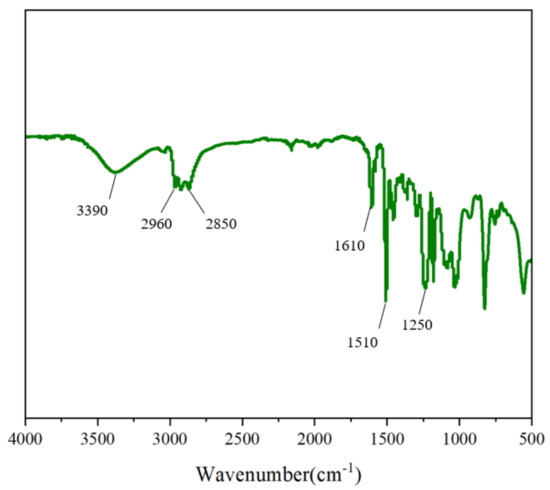
Figure 1.
FTIR spectrum of synthesized poly-BDEB.
3.3. Compressive Strength Analysis
During the preparation of the branched resin poly-BDEB, a cylindrical experimental sample was created by placing the material into a cylindrical mold, as a specific shape is necessary for testing its compressive strength. The mechanical properties of the branched resin poly-BDEB were analyzed using a hydraulic servo-driven controlled universal testing machine. The results of the mechanical property analysis of the branched resin poly-BDEB are shown in Figure 2. During the compression process, the molecular structure of the material undergoes corresponding changes. Specifically, the benzene rings and ether bonds within the branched structure may undergo slight deformation under pressure, leading to enhanced intermolecular interactions. This strengthened interaction facilitates the distribution of external stress, thereby improving the overall compressive strength of the material. When the pressure is 198.33 MPa poly-BDEB is crushed. This indicates that the compressive strength of the branched resin poly-BDEB is 198.33 MPa. Under high pressure, the branched resin poly-BDEB can still maintain a stable structure.
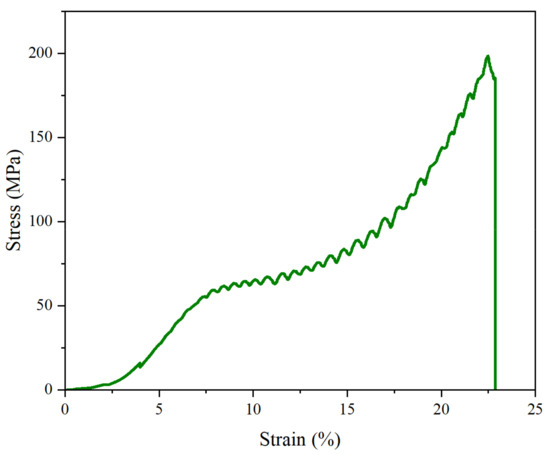
Figure 2.
Mechanical properties analysis of poly-BDEB.
3.4. Thermogravimetric Analysis
The thermal stability of the branched resin poly-BDEB was investigated by thermogravimetric analysis. Figure 3 shows the thermogravimetric curve of the branched resin poly-BDEB. The mass loss of the branched resin poly-BDEB from 30.00 °C to 352.25 °C was 6.14%, primarily attributed to the bound water on the surface of the resin. The mass loss of the branched resin poly-BDEB from 352.25 °C to 445.50 °C occurred rapidly, with a mass loss of 83.65%. This mass loss is attributed to the thermal decomposition of the branched resin poly-BDEB resulting from structural damage. These findings indicate that the initial thermal decomposition temperature of the branched resin poly-BDEB is 352.25 °C, demonstrating good thermal stability.

Figure 3.
Thermal stability analysis of poly-BDEB.
3.5. Scanning Electron Microscopy Analysis
Spherical bridging leakage control materials are prone to movement or detachment due to various factors (such as temperature and vibration) during the plugging process, which may lead to the destruction of the plugging layer and subsequent plugging failure. Therefore, in the preparation of low-density, high-pressure epoxy resin leakage control materials, it is essential to strive for an irregular morphology to achieve a stable bridging effect within the cracks and form a reliable blocking layer. The prepared branched resin poly-BDEB was pulverized using a pulverizer, and different particle sizes were obtained by controlling the pulverization duration. The material was then subjected to scanning electron microscopy (SEM) testing to observe its morphology. Figure 4 presents scanning electron microscope images of the branched resin poly-BDEB at various magnifications. As shown in Figure 4, the scanning electron microscopy (SEM) images of branched resin poly-BDEB particles at different magnifications reveal a dense, irregular polyhedral morphology. The particle surfaces appear rough with distinct textural features, which may be attributed to the high degree of intermolecular crosslinking during synthesis. Additionally, some fractured particles exhibit relatively uniform fracture surfaces, indicating a dense internal structure and a certain degree of toughness. Meanwhile, certain particles display layered or coarse fracture patterns at the fracture interface, possibly due to localized stress concentrations or the presence of microscopic defects. These unique morphological characteristics facilitate particle bridging within fractures, enhancing the stability and mechanical strength of the sealing layer, thereby improving the overall lost circulation control performance.
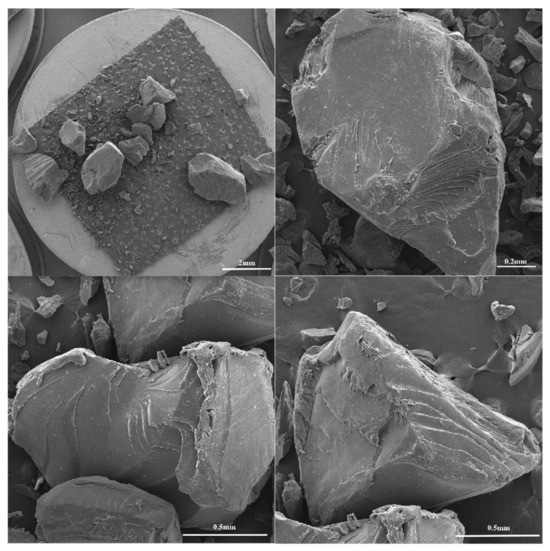
Figure 4.
External shapes of the branched resin poly-BDEB at different magnifications.
3.6. Analysis of the Performance of Resin Materials for Leakage Plugging
3.6.1. Settlement Stability Analysis
The density of the branched resin poly-BDEB was measured to be 1.07 g/cm3 using a density tester. Table 1 illustrates the changes in the density of the drilling fluid following the addition of branched resin poly-BDEB particles (LCM-A, LCM-B, LCM-C). The results indicate that the density of the drilling fluid increases from 1.030 g/cm3 to 1.0378 g/cm3 with the addition of poly-BDEB particles. The density difference between the upper and lower fluids after settling ranges from 0.0007 to 0.0024 g/cm3. This indicates that when the concentration of branched resin poly-BDEB in the drilling fluid reaches 24% (8%A + 8%B + 8%C), it still maintains good sedimentation stability. This characteristic is beneficial for achieving a continuous plugging effect at the leakage channels.

Table 1.
Changes in drilling fluid density.
3.6.2. Rheological Performance Analysis of Drilling Fluids
Rheology is the study of the deformation and flow behavior of fluids in response to external forces. Rheological measurements such as viscosity indicate how a fluid flows under various conditions. To evaluate the effect of poly-BDEB particle concentration on the rheology of drilling fluids, three sizes of poly-BDEB particles (LCM-A, LCM-B, and LCM-C) were incorporated into the base mud at concentrations of 2.0, 4.0, 6.0, and 8.0 wt%, respectively. Figure 5 illustrates the impact of incorporating different particle sizes on the rheology of the drilling fluid. The results indicate that incorporating 8% of poly-BDEB particles of varying sizes (LCM-A, LCM-B, and LCM-C) into the drilling fluid system has minimal impact on its rheology, thereby ensuring that the drilling fluid maintains good fluidity and stability post-addition.
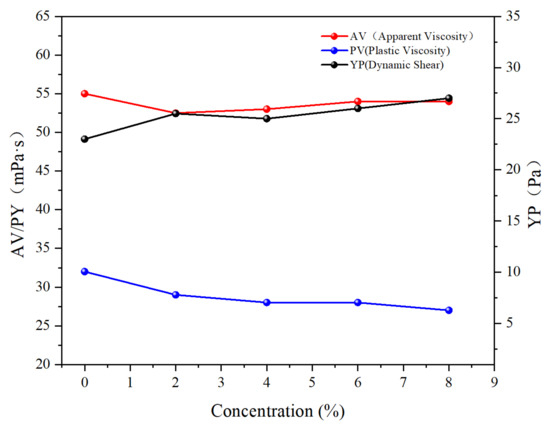
Figure 5.
The impact of incorporating different particle sizes on the rheology of the drilling fluid.
3.6.3. Leakage Control Performance Analysis
In deep and ultra-deep well drilling operations, the complexity of the formation significantly affects the flow of drilling fluids and downhole operations. In particular, the presence of multi-stage fractures increases the likelihood of plugging failures and poses substantial challenges to the effectiveness of plugging efforts. Multi-stage fractures refer to the existence of multiple fracture systems in the formation, which may vary considerably in terms of depth, direction, size, and openness. The intricate nature of multi-stage fractures imposes higher demands on the selection of plugging materials and the application of plugging techniques during drilling. The presence of multi-stage fractures significantly complicates the plugging process during drilling operations. In the face of a complex formation environment, selecting appropriate plugging materials and methods, optimizing workflows, and precisely controlling injection rates and pressure are critical to ensuring the effectiveness of plugging. In this study, core pressure plugging experimental tests were conducted on single-stage cracks measuring 1–2 mm and 2–3 mm, as well as on multi-stage cracks measuring 1–3 mm. Figure 6 illustrates the results of the pressurized plugging test for single-stage cracks measuring 1–2 mm. Figure 7 presents the results of the pressurized leakage plugging test for single-stage cracks measuring 2–3 mm. Figure 8 displays the results of the pressurized plugging test for multi-stage cracks measuring 1–2 and 2–3 mm. The results indicate that as the cracks transition to multi-stage configurations, their width increases, necessitating larger particle sizes and concentrations of leakage control materials. A combination of 1% A and 1% B poly-BDEB particles can effectively seal a single-stage crack measuring 1–2 mm at a pressure of 10.5 MPa. A mixture of 2% A, 5% B, and 2% C can effectively seal a single-stage crack measuring 2–3 mm at a pressure of 10.5 MPa. A formulation of 4% A, 6% B, and 6% C can effectively seal multi-stage cracks measuring 1–2 mm and 2–3 mm under a bearing pressure of 10.5 MPa.
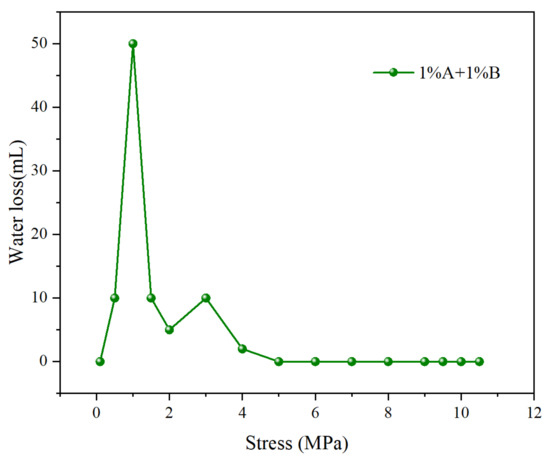
Figure 6.
The pressurized plugging test for single-stage cracks measuring 1–2 mm.
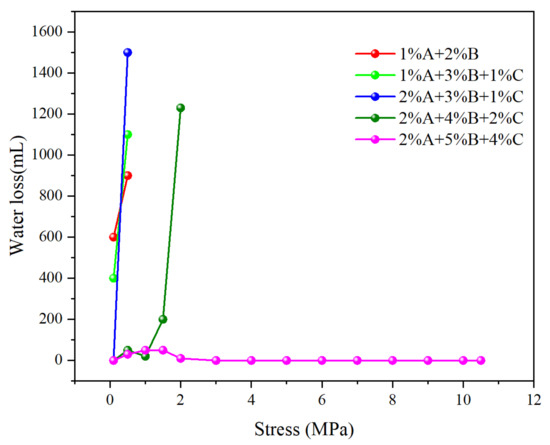
Figure 7.
The pressurized leakage plugging test for single-stage cracks measuring 2–3 mm.
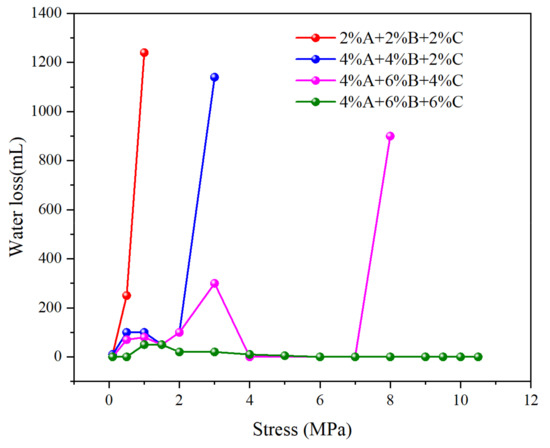
Figure 8.
The pressurized plugging test for multi-stage cracks measuring 1–2 and 2–3 mm.
3.7. Possible Mechanisms of Leakage Control
The particle size grading of materials plays a crucial role in enhancing the formation’s pressure-bearing capacity. If the particles are too large, they tend to accumulate at the entrance of fractures during application. While this may temporarily enhance the pressure-bearing capacity, the materials at the fracture entrance are prone to damage due to the erosion of drilling fluids or collisions between the drill string and the well wall, ultimately leading to a reduction in pressure-bearing capacity. Conversely, if the particles are too small, they may continuously infiltrate the formation with the filtrate of drilling fluids, failing to form an effective seal within the fractures and thus providing no significant improvement. Therefore, only a well-graded particle size distribution can effectively enhance the formation pressure-bearing capacity.
The shape of plugging particles significantly influences their effectiveness in sealing. Fiber particles lack sufficient strength to serve as effective bridging materials. When the planar size of the particles exceeds the crack width, sheet particles may fail to penetrate the cracks resulting in an apparent but ineffective sealing effect. Conversely, if the planar size is smaller than the crack width, the particles can easily enter the cracks but are less likely to achieve effective bridging. Thus, flaky particles are unsuitable as bridging materials. The synthesized poly-BDEB bridging particles exhibit irregular (angular) shapes, resembling polyhedra between cubic and spherical forms. This morphology ensures that the particles are not strictly aligned along the flow direction but can adjust orientation dynamically with the flow. Consequently, they have an equal likelihood of entering and becoming lodged within the cracks, facilitating effective bridging.
4. Conclusions
Poly-BDEB, a low-density branched resin resistant to high pressure and high temperature, was synthesized and evaluated using 2,2-bis(4-hydroxyphenyl)propane diepoxyglycidyl ether and epoxy crack adhesive B. Poly-BDEB exhibited structural stability at a pressure of 198.33 MPa. The structural characteristics of poly-BDEB were further evaluated. The structure of poly-BDEB demonstrates stability at 352.25 °C. This indicates that it exhibits strong resistance to thermal decomposition and high pressure under the characteristic high-temperature and pressure conditions of deep and ultra-deep wells. Poly-BDEB has a density of 1.07 g/cm3, allowing for improved suspension in drilling fluids. The branched resin poly-BDEB effectively plugs single-stage and multi-stage fractures measuring 1–2 mm and 2–3 mm. It features an irregular shape, which facilitates bridging during the fracture transport process, thereby forming a stable blocking layer more effectively than spherical particles. This indicates that the branched resin poly-BDEB can maintain good structural stability under high temperatures and pressures, effectively providing a plugging effect for leakage in deep and ultra-deep wells.
Author Contributions
Methodology, C.W. and K.F.; software, C.W.; validation, T.W. and G.X.; investigation, Z.Z.; data curation, Z.Z.; writing—original draft, K.F.; writing—review and editing, K.F.; project administration, T.W. and G.X. All authors have read and agreed to the published version of the manuscript.
Funding
This research received no external funding.
Data Availability Statement
The original contributions presented in this study are included in the article. Further inquiries can be directed to the corresponding author.
Conflicts of Interest
Authors Chunsheng Wang, Zhen Zhang and Tao Wang were employed by the R&D Center for Ultra Deep Complex Reservior Exploration and Development, China National Petroleum Corporation (CNPC) and Petrochina Tarim Oilfield Company. The remaining authors declare that the research was conducted in the absence of any commercial or financial relationships that could be construed as a potential conflict of interest.
References
- Sedaghatzadeh, M.; Shahbazi, K.; Pourafshary, P.; Razavi, S.A. Experimental investigation of the application of Eucalyptus bark to prevent lost circulation in pay zones with acid dissolution capability. Petroleum 2021, 7, 152–159. [Google Scholar] [CrossRef]
- Retnanto, A.; Yrac, R.; Shaat, A.; Retnanto, A.; Abughaush, L.; Al Sulaiti, M.; Badar, N. Evaluation of the viability of nanoparticles in drilling fluids as additive for fluid loss and wellbore stability. Petroleum 2023, 9, 342–351. [Google Scholar] [CrossRef]
- Xu, Z.; Sun, J.S.; Li, L.; Lv, K.H.; Liu, J.P.; Dai, Z.W.; Zhang, X.F.; Wang, Z.L. Development and performance evaluation of a high temperature resistant, internal rigid, and external flexible plugging agent for water-based drilling fluids. Petroleum 2023, 9, 33–40. [Google Scholar] [CrossRef]
- Yang, L.; Xie, C.; Zhang, Y.; Jiang, G.; Wu, Y.; Liu, H.; Dong, T.; Guo, C. Performance of Self-healing microgel incorporating Nano-Silica as plugging material for drilling fluid. J. Mol. Liq. 2023, 386, 122392. [Google Scholar] [CrossRef]
- Sun, J.S.; Bai, Y.R.; Cheng, R.C.; Lyu, K.H.; Liu, F.; Feng, J.; Lei, S.F.; Zhang, J.; Hao, H.J. Research progress and prospect of plugging technologies for fractured formation with severe lost circulation. Pet. Explor. Dev. 2021, 48, 732–743. [Google Scholar] [CrossRef]
- Zheng, X.; Duan, Z.; Zhuang, Y.; Zhang, S.; Cui, X.; Qin, D. Application of Solvent-Assisted Dual-Network Hydrogel in Water-Based Drilling Fluid for Lost Circulation Treatment in Fractured Formation. ACS Omega 2023, 9, 1166–1173. [Google Scholar] [CrossRef] [PubMed]
- Yan, X.P.; You, L.J.; Kang, Y.L.; Deng, S.; Xu, C.Y. Formation Damage Induced by Oil-Based Drilling Fluid in a Longmaxi Shale Gas Reservoir: A Comprehensive View of the Drilling, Stimulation, and Production Processes. Energy Fuels 2022, 37, 945–954. [Google Scholar] [CrossRef]
- Jiang, G.; Sun, J.; He, Y.; Cui, K.; Dong, T.; Yang, L.; Yang, X.; Wang, X. Novel Water-Based Drilling and Completion Fluid Technology to Improve Wellbore Quality During Drilling and Protect Unconventional Reservoirs. Engineering 2022, 18, 129–142. [Google Scholar] [CrossRef]
- Ziaie, M.; Fazaelizadeh, M.; Tanha, A.A.; Sharifzadegan, A. Estimation of the horizontal in-situ stress magnitude and azimuth using previous drilling data. Petroleum 2023, 9, 352–363. [Google Scholar] [CrossRef]
- Pu, L.; Xu, P.; Xu, M.B.; Song, J.J.; He, M. Lost circulation materials for deep and ultra-deep wells: A review. J. Pet. Sci. Eng. 2022, 214, 110404. [Google Scholar] [CrossRef]
- Su, X.M.; Lian, Z.H.; Fang, J.W.; Xiong, H.Q.; Wu, R.N.; Yuan, Y. Lost circulation material for abnormally high temperature and pressure fractured-vuggy carbonate reservoirs in Tazhong block, Tarim Basin, NW China. Pet. Explor. Dev. 2019, 46, 173–180. [Google Scholar] [CrossRef]
- Sun, D.L.; Yang, Y.; Ma, W.J.; Ye, S.X.; Zhang, H.; Zhang, J.; Yang, B. Heat-Resistant Hydrogel for Temporary Plugging in High-Temperature and High-Pressure Fractured Reservoirs. ACS Appl. Polym. Mater. 2023, 5, 7746–7754. [Google Scholar] [CrossRef]
- Vivas, C.; Salehi, S. Screening of Lost Circulation Materials for Geothermal Applications: Experimental Study at High Temperature. J. Energy Resour. Technol. 2022, 144, 033008. [Google Scholar] [CrossRef]
- Tian, J.; Liu, J.; Liu, S.; Yuan, S.; Cai, W.; Jiang, H. A gel system with long-term high-temperature stability for deep profile modification of high-temperature oil and gas reservoirs. J. Appl. Polym. Sci. 2023, 140, e54733. [Google Scholar] [CrossRef]
- Movahedi, H.; Jamshidi, S.; Hajipour, M. Hydrodynamic Analysis and Cake Erosion Properties of a Modified Water-Based Drilling Fluid by a Polyacrylamide/Silica Nanocomposite during Rotating-Disk Dynamic Filtration. ACS Omega 2022, 7, 44223–44240. [Google Scholar] [CrossRef]
- Cui, K.; Jiang, G.; Xie, C.; Yang, L.; He, Y.; Shen, X.; Wang, X. A novel temperature-sensitive expandable lost circulation material based on shape memory epoxy foams to prevent losses in geothermal drilling. Geothermics 2021, 95, 102145. [Google Scholar] [CrossRef]
- Zhai, K.; Yi, H.; Liu, Y.; Geng, Y.; Fan, S.; Zhu, D. Experimental Evaluation of the Shielded Temporary Plugging System Composed of Calcium Carbonate and Acid-Soluble Preformed Particle Gels (ASPPG) for Petroleum Drilling. Energy Fuels 2020, 34, 14023–14033. [Google Scholar] [CrossRef]
- Lin, C.; Taleghani, A.D.; Kang, Y.; Xu, C. A coupled CFD-DEM simulation of fracture sealing: Effect of lost circulation material, drilling fluid and fracture conditions. Fuel 2022, 322, 124212. [Google Scholar] [CrossRef]
- Huang, B.; Zhang, W.; Zhou, Q.; Fu, C.; He, S. Preparation and Experimental Study of a Low-Initial-Viscosity Gel Plugging Agent. ACS Omega 2020, 5, 15715–15727. [Google Scholar] [CrossRef]
- Fan, X.; Zhao, P.; Zhang, Q.; Zhang, T.; Zhu, K.; Zhou, C. A Polymer Plugging Gel for the Fractured Strata and Its Application. Materials 2018, 11, 856. [Google Scholar] [CrossRef]
- Li, J.; Zhou, L.; Liu, S. Novel smart plugging material for high-temperature gas well. Polym. Eng. Sci. 2023, 63, 2409–2420. [Google Scholar] [CrossRef]
- Zhu, J.; Lou, E.; Zhang, S.; Lu, H.; Wang, Z. Preparation and Performance of Resin-Gel–Rubber Expandable Lost Circulation Material Blend. Gels 2023, 9, 862. [Google Scholar] [CrossRef]
- Jia, H.; Wu, J.Y.; Wu, S.W.; Liang, Y.B.; Wang, M.H.; Wan, X.J.; Li, P.W. New insights into the DPR mechanism of elastic energy released by polymer gel for enhanced oil recovery. Petroleum 2024, 10, 539–547. [Google Scholar] [CrossRef]
- Lashkari, R.; Tabatabaei-Nezhad, S.A.; Husein, M.M. Shape Memory Polyurethane as a Drilling Fluid Lost Circulation Material. Macromol. Mater. Eng. 2021, 306, 2100354. [Google Scholar] [CrossRef]
- Luo, Y.M.; Shang, Q.G.; Hu, H.; Bai, X.D. Preparation of Expandable Polymer Plugging Agent and Its Application in Water-Based Drilling Fluid. J. Appl. Polym. Sci. 2024, 142, e56546. [Google Scholar] [CrossRef]
- Liu, H.B.; Li, X.M.; Pan, Z.; Dai, L.; Zhang, M.; Shen, F.; Si, C.L. Lignin-based plugging hydrogel with high-temperature resistance and adjustable gelation. Adv. Compos. Hybrid Mater. 2025, 8, 1–15. [Google Scholar] [CrossRef]
- Xu, P.; Yu, J.; Xie, L. Synthesis and Evaluation of Plugging Gel Resistant to 140 °C for Lost Circulation Control: Effective Reduction in Leakage Rate in Drilling Process. Polymers 2024, 16, 1658. [Google Scholar] [CrossRef]
- Lv, K.; Zhu, Q.; Yin, H.; Feng, Y. Slow Curing of Epoxy Resin Underwater at High Temperatures. Ind. Eng. Chem. Res. 2022, 61, 16935–16945. [Google Scholar] [CrossRef]
- Sun, Y.; Sun, J.; Li, L.; Lv, K.; Zhang, X.; Wang, Z.; Dai, Z.; Xu, Z.; Zhang, T.; Liu, J. Development of High-Temperature and High-Mineralization-Resistant Adaptive Plugging Agent and Its Performance Evaluation. Energy Fuels 2023, 37, 8999–9010. [Google Scholar] [CrossRef]
- Elahifar, B.; Hosseini, E. Laboratory study of plugging mechanism and seal integrity in fractured formations using a new blend of lost circulation materials. J. Pet. Explor. Prod. Technol. 2023, 13, 1197–1234. [Google Scholar] [CrossRef]
- Yang, J.-B.; Bai, Y.-R.; Sun, J.-S.; Lv, K.-H. Curing kinetics and plugging mechanism of high strength curable resin plugging material. Pet. Sci. 2024, 21, 3446–3463. [Google Scholar] [CrossRef]
- Khoshmardan, M.A.; Behbahani, T.J.; Ghotbi, C.; Nasiri, A. Experimental investigation of mechanical behavior and microstructural analysis of bagasse fiber-reinforced polypropylene (BFRP) composites to control lost circulation in water-based drilling mud. J. Nat. Gas Sci. Eng. 2022, 100, 104490. [Google Scholar] [CrossRef]
- Romão, B.M.V.; Diniz, M.F.; Azevedo, M.F.P.; Lourenço, V.L.; Pardini, L.C.; Dutra, R.C.; Burel, F. Caracterização por FT-IR de agentes de cura utilizados em resinas epoxídicas II-polimercaptana, poliaminoamida e amina modificada. Polímeros 2003, 13, 173–180. [Google Scholar] [CrossRef]
Disclaimer/Publisher’s Note: The statements, opinions and data contained in all publications are solely those of the individual author(s) and contributor(s) and not of MDPI and/or the editor(s). MDPI and/or the editor(s) disclaim responsibility for any injury to people or property resulting from any ideas, methods, instructions or products referred to in the content. |
© 2025 by the authors. Licensee MDPI, Basel, Switzerland. This article is an open access article distributed under the terms and conditions of the Creative Commons Attribution (CC BY) license (https://creativecommons.org/licenses/by/4.0/).